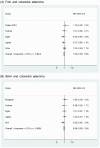Circulating levels of vitamin D, vitamin D receptor polymorphisms, and colorectal adenoma: a meta-analysis
- PMID: 22125685
- PMCID: PMC3221833
- DOI: 10.4162/nrp.2011.5.5.464
Circulating levels of vitamin D, vitamin D receptor polymorphisms, and colorectal adenoma: a meta-analysis
Abstract
Growing evidence suggests an elevated risk for colorectal neoplasia among individuals with low levels of vitamin D, the biological actions of which are mediated by the vitamin D receptor (VDR). To investigate the association among vitamin D status, VDR polymorphisms (FokI, and BsmI), and colorectal adenoma, we conducted a meta-analysis of nine studies of circulating levels of 25-hydroxyvitamin D (25(OH)D) and five studies of FokI or BsmI polymorphisms in relation to colorectal adenomas. Study-specific relative risks (RRs) and 95% confidence intervals (CIs) were pooled using a random-effects model. A total of 3398 colorectal adenomas for 25(OH)D and 1754 colorectal adenomas for VDR were included in the meta-analysis. We identified a significant inverse association between colorectal adenoma (combined RR, 0.93; 95% CI, 0.87-0.98 per 10 ng/mL increase in 25(OH)D levels). When we examined FokI and BsmI polymorphisms in the meta-analysis, we found no association for either FokI (combined RR, 1.00; 95% CI, 0.95-1.06) or BsmI (combined RR, 0.99; 95% CI, 0.93-1.05) in the additive model. These data suggest an inverse association between circulating 25(OH)D levels and colorectal adenoma risk.
Keywords: 25-hydroxyvitamin D; Colorectal adenoma; meta-analysis; vitamin D receptor.
Figures


Similar articles
-
Circulating levels of vitamin D and colorectal adenoma: A case-control study and a meta-analysis.World J Gastroenterol. 2015 Aug 7;21(29):8868-77. doi: 10.3748/wjg.v21.i29.8868. World J Gastroenterol. 2015. PMID: 26269676 Free PMC article. Review.
-
Association of polymorphisms in the vitamin D receptor gene and serum 25-hydroxyvitamin D levels in children with autism spectrum disorder.Gene. 2016 Aug 22;588(2):109-14. doi: 10.1016/j.gene.2016.05.004. Epub 2016 May 4. Gene. 2016. PMID: 27155524
-
Meta-analyses of vitamin D intake, 25-hydroxyvitamin D status, vitamin D receptor polymorphisms, and colorectal cancer risk.Cancer Epidemiol Biomarkers Prev. 2011 May;20(5):1003-16. doi: 10.1158/1055-9965.EPI-10-1141. Epub 2011 Mar 4. Cancer Epidemiol Biomarkers Prev. 2011. PMID: 21378269
-
Vitamin D, calcium, and vitamin D receptor polymorphism in colorectal adenomas.Cancer Epidemiol Biomarkers Prev. 2001 Dec;10(12):1267-74. Cancer Epidemiol Biomarkers Prev. 2001. PMID: 11751444
-
Additively protective effects of vitamin D and calcium against colorectal adenoma incidence, malignant transformation and progression: A systematic review and meta-analysis.Clin Nutr. 2020 Aug;39(8):2525-2538. doi: 10.1016/j.clnu.2019.11.012. Epub 2019 Nov 16. Clin Nutr. 2020. PMID: 31784301
Cited by
-
High Prevalence of Vitamin D Deficiency in Cambodian Women: A Common Deficiency in a Sunny Country.Nutrients. 2016 May 12;8(5):290. doi: 10.3390/nu8050290. Nutrients. 2016. PMID: 27187456 Free PMC article.
-
Vitamin D and Major Chronic Illness.J Restor Med. 2012 Sep;1(1):9-23. doi: 10.14200/jrm.2012.1.1001. J Restor Med. 2012. PMID: 30197839 Free PMC article.
-
Prevention of preneoplastic lesions by dietary vitamin D in a mouse model of colorectal carcinogenesis.J Steroid Biochem Mol Biol. 2013 Jul;136:284-8. doi: 10.1016/j.jsbmb.2012.09.003. Epub 2012 Sep 11. J Steroid Biochem Mol Biol. 2013. PMID: 22982628 Free PMC article.
-
Vitamin D and colorectal cancer: molecular, epidemiological and clinical evidence.Br J Nutr. 2016 May;115(9):1643-60. doi: 10.1017/S0007114516000696. Br J Nutr. 2016. PMID: 27245104 Free PMC article. Review.
-
Circulating levels of vitamin D and colorectal adenoma: A case-control study and a meta-analysis.World J Gastroenterol. 2015 Aug 7;21(29):8868-77. doi: 10.3748/wjg.v21.i29.8868. World J Gastroenterol. 2015. PMID: 26269676 Free PMC article. Review.
References
-
- Lamprecht SA, Lipkin M. Cellular mechanisms of calcium and vitamin D in the inhibition of colorectal carcinogenesis. Ann N Y Acad Sci. 2001;952:73–87. - PubMed
-
- Fraser DR. Biochemical and clinical aspects of vitamin D function. Br Med Bull. 1981;37:37–42. - PubMed
-
- Tangpricha V, Flanagan JN, Whitlatch LW, Tseng CC, Chen TC, Holt PR, Lipkin MS, Holick MF. 25-hydroxyvitamin D-1alpha-hydroxylase in normal and malignant colon tissue. Lancet. 2001;357:1673–1674. - PubMed

